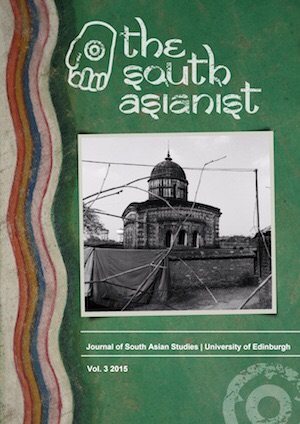Hindu heroes and Muslim others: an analysis of the portrayal of Partition in Kamal Haasan's Hey Ram (2000), Rakeysh Omprakash Mehra's Bhaag Milkha Bhaag (2013), and M. S. Sathyu's Garam Hawa (1973).
Abstract
With reference to their portrayals of Partition, I discuss the value of Kamal Haasan’s Hey Ram! (2000), Rakeysh Omprakash Mehra's Bhaag Milkha Bhaag (2013), and M. S. . Sathyu's Garam Hawa (1973) as historical resources. I emphasize how the ‘othering’ of Muslims in Hey Ram! and Bhaag Milkha Bhaag finds expression in terms of masculinity and Indian patriotism. Drawing on Vasudevan’s (2002) critique of Hey Ram!, I argue that Kamal Haasan does not offer viewers sufficient distance from the film’s Hindu-extremist protagonist, thus curbing their ability to critique the Hindutva historical narrative portrayed. Further, Haasan’s intended dismissal of this Hindutva narrative of Hindu loss and Muslim murder falls short due to its portrayal of the film’s central Muslim character as relatively effeminate and in need of Hindu paternalism. Similarly, Muslim-Hindu relations (as well as national anxieties about Indian identity and culture) are configured through a play between masculinities in biopic Bhaag Milkha Bhaag, as commented upon by Kumar (2014). Through a track-and-field victory in Pakistan, Milkha redeems the emasculation caused by his flight from the Punjab during Partition. I discuss Garam Hawa as a counterpoint to Hey Ram! and Bhaag Milkha Bhaag, both of which I read as mostly congruous with secular official historiography. In addition to presenting the perspective of members of the Indian Muslim minority that stayed behind after Partition, Garam Hawa digs up financial and sentimental motives for belonging in India that are absent from the official historical narrative of Partition.
Downloads
References
Benegal, Shyam. (2007). ‘Secularism and Popular Indian Cinema’ in Dingwaney Needham, Anuradha and Sunder Rajan, Rajeswari (ed.) The Crisis of Secularism in India, London: Duke University Press, 2007~
Chatterjee, P. (1989). Colonialism, nationalism, and colonialized women: The contest in India. American ethnologist 16 (4): 622-633. Chaturvedi, Vinayak. (2007) ‘A critical theory of Subalternity: Rethinking class in Indian historiography.’ Left History 12 (1)
Hasan, Mushirul. (1997) Legacy of a divided nation: India’s Muslims since independence. Westview Press, Boulder
Just Another Film Critic. (2008) ‘Taming of the Unmanned Elephant - An Analysis of Kamal Haasan’s Hey Ram (1999)’ Accessed at
<http://theseventhart.files.wordpress.com/2008/06/taming-of-the-unmanned-elephant.pdf> on 28 October 2014
Kumar, Preeti. (2014) ‘Reconfiguring India: Narrating the Nation through Great Men Biopics’
in The IAFOR Journal of Media, Communication and Film 1 (2)
Prakash, G. (1992). ‘Postcolonial criticism and Indian historiography.’ Social Text: 8-19.
Roy, P. (2013) Scorching Winds - A Review of Garam Hava, The Orissa Post (Bubaneshwar), 31 October 2013, p. 14
Vasudevan, R. (2002), ‘Another History Rises to the Surface: ‘Hey Ram’: Melodrama in the
Age of Digital Simulation’ in Economic and Political Weekly 37 (28): 2917-2925
Viswanath, G. and Malik, S. (2009), ‘Revisiting 1947 through Popular Cinema: A
Comparative Study of India and Pakistan’ in Economic and Political Weekly 44 (36):61-69 Film
Bhaag Milkha Bhaag. DVD. Directed by Mehra R.O. (12 July 2013); Mumbai: ROMP Pictures
Garam Hawa. Film. Directed by Sathyu M.S. (November 1973); Mumbai: Film Finance Corporation
Hey Ram!. DVD. Directed by Hasaan K. (18 February 200); Chennai, Raajkamal Films International




